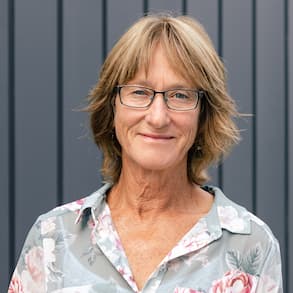Tackling social housing needs

Nelson Tasman Housing Trust director, Carrie Mozena. Photo: Kate Russell.
Finding suitable sites for social housing in the Nelson-Tasman region will continue to be the stumbling block for community housing providers, despite the Government’s plan to get them building more.
Nelson Tasman Housing Trust director, Carrie Mozena, says it needs to find and successfully purchase land for its housing developments and those sites are hard to find in the region.
The Government announced last week that it wanted community housing providers to carry out more of the social housing developments. It followed an independent review of Kāinga Ora that found the Crown entity was underperforming and not financially viable.
“I think it is important and good that the Government is scrutinising the financial performance of Kāinga Ora because a huge, mind-boggling amount of taxpayer money has been going into Kāinga Ora and not as much as anyone expected has been delivered on the ground.
“There’s so many people in the community who need secure, warm, healthy homes and it bothers me that there is so much money that has gone into Kāinga Ora and they haven’t been able to deliver.”
She concedes Kāinga Ora has had to build a pipeline in the past few years that includes ramping up staff numbers, identifying sites, planning and then building the homes, which takes time. It also deals with people who have very complex needs. But she says it has been moving slowly when the need for social housing is increasing.
In the trust’s latest housing need survey, which monitors the housing need beyond the Ministry of Social Development housing register, there are 686 households in Nelson-Tasman needing affordable housing.
The figure is calculated by adding up waitlists for Nelson Tasman Housing Trust, Tasman District Council housing, Habitat for Humanity, Abbeyfield, Franklyn Village, campgrounds and refugee families via Red Cross. That figure is in addition to the 471 households on the public housing register.
Carrie says the community housing providers, including Habitat for Humanity and Abbeyfield, already collaborate and cooperate with each other where possible and last year Te Āwhina Marae in Motueka contracted the trust for its tenancy management. She says more cooperation is needed with Kāinga Ora as well.
“I would certainly like to see much more cooperation between community housing providers and Kāinga Ora because up to this point it has felt like we’ve been in competition.”
In the recent past, the trust and Kāinga Ora have competed against each other to buy a couple of large sites in Nelson for potential developments.
Carrie says the trust has been able to average one new site a year for the past few years because it needs sites that are a minimum of 800 square metres - and preferably larger – which are near public transport and services. Those are hard to find, and then it has to compete for those sites and go through the council consent process which all takes time.
So far, the trust has 54 homes tenanted with a further 24 being developed in Nelson, and is working with a vendor in Richmond with the hope of building 12 homes there. She says the trust is keen to make progress in Tasman, but it comes back to finding sites close to public transport and services which rules out many rural communities.
She says Nelson-Tasman is one of the least affordable places to live in the country, mostly because incomes are relatively low.
“An awful lot of people in private rentals are just hanging on by their fingernails. They could be spending 70 per cent of their weekly income just paying the rent, so are pretty desperate. Those are folks who need affordable housing.”
Plus, she says there are people staying with family, friends, sleeping in a garage or suddenly find their financial situation changes, leaving them struggling to find affordable housing.
Infometrics indicates Tasman’s mean per capita income for the year ended March 2024 was $42,917 compared with the national average of $50,823 and Wellington region $58,721.
